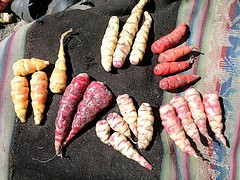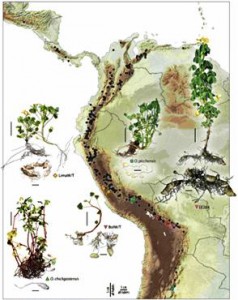Our regular reader botany professor Eve Emshwiller makes a plea on behalf of some under-appreciated — though not by her — Andean crops.
“That’s a potato?” asks the heading of the photo gallery called “Potato Variety” in the “Food Ark” feature on the loss and conservation of agricultural biodiversity in the latest National Geographic Magazine. Well, actually, no. No, not all of the images shown are potatoes. Five of the eighteen tubers shown are oca, Oxalis tuberosa, one of the three other Andean tuber crops.
As far as I can tell, the gallery of “Uncommon Chickens” and the one for “Rare Cattle” didn’t include any ducks, turkeys, or goats. People would have noticed. In the case of their “Potato Variety” gallery, on the other hand, they missed half of the story. If they’d gotten it right, they would have been able to educate their readers about more than variation within a single crop. They could have gone on to explain about the values of cultivating a diversity of different species, diversity that far exceeds even that in the amazing native Andean potatoes.
 The three “minor” tuber crops may not have gained the worldwide importance of the potato, but for a story that focused on the loss of diversity, these other tubers offer even more poignant examples. In my travels in Peru with the germplasm coordinators of INIA (which currently stands for Instituto Nacional de Innovación Agraria), we came across many places where oca was being abandoned by farmers, due either to severe weevil larvae infestations, or in favor of more marketable crops such as commercial potato varieties.
The three “minor” tuber crops may not have gained the worldwide importance of the potato, but for a story that focused on the loss of diversity, these other tubers offer even more poignant examples. In my travels in Peru with the germplasm coordinators of INIA (which currently stands for Instituto Nacional de Innovación Agraria), we came across many places where oca was being abandoned by farmers, due either to severe weevil larvae infestations, or in favor of more marketable crops such as commercial potato varieties.
Among the not-so-lost crops from long-before-the-Incas, are a whole bunch of Andean root and tuber crops (often lumped together as ARTs). Ancient Andean people not only domesticated potatoes in all their incredible diversity, but also other tuber crops from three completely different plant families. For those who haven’t met them yet, the three non-potato Andean tubers are (1) oca, Oxalis tuberosa, of the Oxalidaceae, the wood sorrel family; (2) ulluco or papa lisa, Ullucos tuberosus, of the Basellaceae, the same family as Malabar spinach; and (3) mashua, añu, or isañu, Tropaeolum tuberosum, from the Tropaeolaceae, the family of garden nasturtiums. None of these are closely related to each other, or closely related to the family to which potatoes belong (Solanaceae, the nightshade family). No other area of the world domesticated so many different tubers.
Ancient Andean people also domesticated several root crops as well, which are also each from a different plant family. 1
Don’t get me wrong, I think it is absolutely wonderful that the NGS is featuring agricultural biodiversity in their magazine and online. Maybe it bodes well for another spurt of attention to this theme from magazine journalists — don’t they return to it every 25 years or so?
In truth, people are constantly mixing up the Andean tubers, so it is really no surprise that it is happening again. Ulluco is often mistaken for a colorful potato, and it seems as if oca and mashua are mistaken for each other more often than not. Many of the images online that are purporting to be oca, are not. Meanwhile, oca is often mistaken for a native Andean potato, just as in the case of the five tubers of oca (one of them fasciated) that were called potato by National Geographic. So, this is not an unusual case.

But, looking on the bright side, at least CIP has a program on ARTs, now prominently displayed on their newly redesigned website, including a brief introduction to the non-potato Andean tuber crops. And I trust that some of the many celebrations of Peruvian food recently featured on this blog certainly must include dishes made with ARTs, in an effort to overcome these crops’ stigma as “poor person’s tubers.”
In fact, perhaps things are better than I thought. See the image in the Food Ark Photo Gallery that has a caption that begins “A nest of hay preserves harvested potatoes and tubers in Pampallacta, Peru.” Pampallacta is part of the Parque de la Papa, yet the tubers pictured are oca again. So, does that mean that the Parque de la Papa is indeed working to preserve the non-potato Andean tubers as well?
Sock it to ’em, Eve!
Maybe the Parque de la Oca’s time has come – you could always include a few incorrectly identified spuds as well.
I’ve got about 20 self sown oca seedlings coming up in my garden this year. This plant is perfectly capable of sexual reproduction here in the UK. Call it vanity, but I like to imagine that I’m creating a little secondary centre of oca diversity in Darkest Cornwall.
You are, Owen.
Speaking of “severe weevil larvae infestations,” there’s no mention of oca in this recent report from CIP about a barrier technique to protect potatoes from weevils, but it seems like it might work on oca weevils if they too cannot fly.
Where did I read that NG is enormously careful about photographs and even sends people back to the field to doublecheck things?
In The Onion?
Yes! I went running to my computer when I saw the “Thats a Potato?” Picture. The 4 are clearly Oca. I did not catch the other one. Well done!
Nice article!
I have ‘Gaia’s Garden’ from our local library, & an entry on perennial (or easily naturalized) veggies which included Crambe (have seed for this) & Chinese Artichoke (???) so had to look it up – & now want to grow a BUNCH of these!!
Where to begin? I can get starts or seeds (depending) from several fairly local nurseries … since going Gluten Free 2 years ago, the search for more variety in my diet has been a lot of fun!
Nadya: Chinese artichoke can be a problem here in Scotland. It is small, knobbly, difficult to prepare for eating and if you miss some at harvest grows again and again through the years.
.
Hello Eve et al.–
I just got back from the Parque de la Papa, and it turns out that they are indeed in the midst of a new repatriation of something like 78 accessions of virus-free oca (I think it’s just oca, with no mashua or ulluco yet) from CIP. They have transferred the vitroplants to soil bags that they are raising in a sterile greenhouse.
If anyone is interested, I’m working on a project with the UPTC in Tunja, Colombia to investigate and promote our local varieties of these tubers and other native Andean crops.
Greg
Does anyone know where a backyard gardener in the USA can purchase Andean “seed potatoes” and/or Andean “seed tubers” for use in one’s own garden? Also, is there any chance that I could purchase “certified organic” versions of these items? I would love to try growing all of these different potatoes and tubers! Thanks!
Eric
I’m a bit late to the party, but if you are still looking, click on my name and you’ll be taken to a link that shows US sources for oca.
Here’s something that I posted not too long ago in the “Radix Root Crops” group (https://www.facebook.com/groups/141198905918483/):
“Someone informed me that Territorial Seed is now selling oca, available as expensive little plants for spring planting. They can only be shipped within the contiguous USA, though.
http://www.territorialseed.com/product/12048” Pricy, though.
I don’t know if there are currently other commercial sources for oca, but I do remember seeing mashua (or añu, or isañu, Tropaeolum tuberosum) listed in a catalog as an ornamental a few years ago. If I see it again I’ll post it here. Anyone know of other sources?